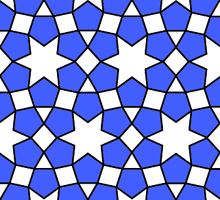

 |
ProemA shocking tale of tilings, semi-regular tilings, demi-regular tilings and rogue polygons yearning to be free. |
|
 |
Methods of ConstructionThe hidden order that lies concealed behind the patterns. A perfect page for conspiracy theorists. |
|
 |
Stained Glass RenderingsHere a selection of designs have been dressed up for a party, enhanced with elaborate lighting, color, or texture, to give an idea of the possible usefulness of these patterns in design. |
|
 |
Polygon WindingsRound and round she goes, where she stops—nobody knows! (Until now, that is.) |
|
 |
Single-Unit, Periodic Patterns
A periodic pattern is one where the entire pattern can be copied and slid to a different position, set down somewhere else on top of itself, and still have all the points and edges coincide. By "slid" we mean "moved in a single direction without performing any rotations or reflections." Math people call this a "translation." Patterns used in wallpaper and fabrics are generally periodic; otherwise, they would be too complicated to manufacture on a large scale. |
|
 |
Triangle PatternsThe simplest of the polygons, the triangle is easy to combine into larger units that form some unexpectedly complex patterns. |
|
 |
Square PatternsSquares play particularly well with hexagons, which enable them to be arranged in snakelike, undulating patterns. |
|
 |
Pentagon PatternsPentagons are one of the most difficult shapes to fit into a repeating pattern. Perhaps as a result, the the patterns that are possible turn out to be very dynamic and striking. |
|
 |
Hexagon PatternsHexagons are relatively easy to arrange into a variety of patterns with simple and attractive shapes between them. |
|
 |
Heptagon PatternsThe negative space in heptagon patterns tends to form bizarre shapes, perhaps because seven is a prime number that doesn't combine naturally with any of the other regular polygons. |
|
 |
Octagon PatternsOctagons can be viewed as squares with truncated corners, or as the intersection of two squares that were overlaid at a 45 degree angle. Perhaps because of that, the octagons tend to fall into patterns that alternate with squares or that fall into a rectangular grid. |
|
 |
Enneagon PatternsThe nine-sided enneagons don't fit together as readily as you might expect, but they do produce one very interesting unit: a set of six enneagons circled around a six-pointed star. |
|
 |
Decagon PatternsThe ten-sided decagons tend to fall naturally into patterns involving pairs or sets of five. |
|
 |
Hendecagon PatternsAs a prime number, and a relatively large one, the eleven presents unusual difficulties, with only a few arrangements that appear relatively harmonious and natural. |
|
 |
Dodecagon PatternsThe twelve-sided dodecagons play together more gracefully, in more different ways, than any other polygon. Perhaps because twelve is divisible by three, four, and six, it easily develops multiple types of symmetry. |
|
 |
Single-Unit, Aperiodic PatternsSome shapes lend themselves most easily to patterns that expand outward from a central point. Such patterns are all aperiodic because you can't overlay two copies of the pattern and have them match up unless the center is at the same position in both. |
|
 |
Pentagon Aperiodic PatternsPentagons like nothing better to fan outward from a central unit that has five-fold symmetry, such as a pentagon, pentagram, or decagon. |
|
Send comments to jfm.baharna@gmail.com
Return to Baharna.com Home Page
© Copyright 2007 by Joseph F. Morales
 A single-unit pattern is one that can be drawn using only a single kind of polygon. Although there may appear to be several kinds of polygons in the pattern, only one of them has to be drawn in. The other shapes consist of the negative space between instances of the primary polygon. For example, in the patern at right, the basic units are all pentagons, which are colored in blue. Between the pentagons, the negative space forms triangles, rhombuses, and six-pointed stars. But no extra lines are needed to form these extra shapes; every line in the picture is part of a pentagon. (If anyone knows a more correct name for this class of pattern, please
A single-unit pattern is one that can be drawn using only a single kind of polygon. Although there may appear to be several kinds of polygons in the pattern, only one of them has to be drawn in. The other shapes consist of the negative space between instances of the primary polygon. For example, in the patern at right, the basic units are all pentagons, which are colored in blue. Between the pentagons, the negative space forms triangles, rhombuses, and six-pointed stars. But no extra lines are needed to form these extra shapes; every line in the picture is part of a pentagon. (If anyone knows a more correct name for this class of pattern, please 